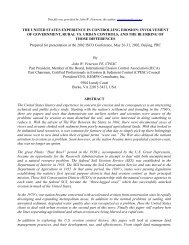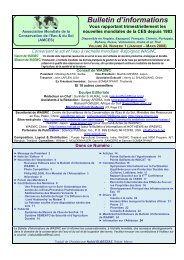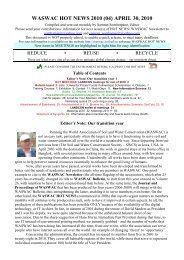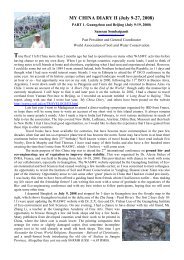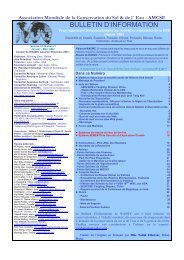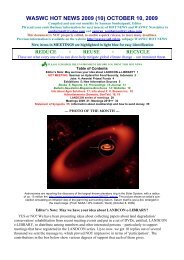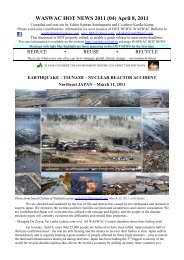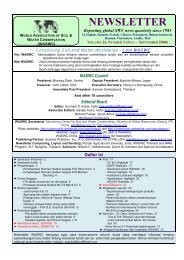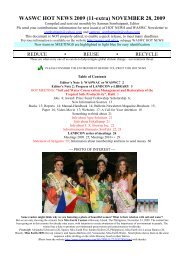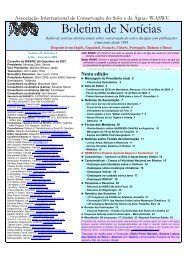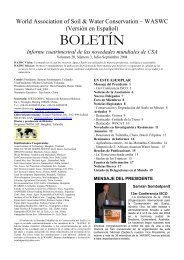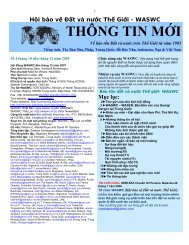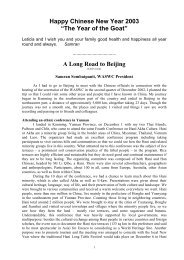Soils of the European Union - European Soil Portal - Europa
Soils of the European Union - European Soil Portal - Europa
Soils of the European Union - European Soil Portal - Europa
Create successful ePaper yourself
Turn your PDF publications into a flip-book with our unique Google optimized e-Paper software.
4.5 ArenosolsGeographical distributionArenosols cover approximately 145,000 km 2 corresponding to 3.61% <strong>of</strong> <strong>the</strong> land surface <strong>of</strong> <strong>the</strong> <strong>European</strong> <strong>Union</strong>. Majorareas <strong>of</strong> Arenosols are located on <strong>the</strong> north-eastern regions <strong>of</strong> <strong>the</strong> EU. However, certain regions in Central Europe, <strong>the</strong> UK,France, Portugal and Spain are also covered by Arenosols. In 340 cases Arenosols form <strong>the</strong> dominant soil reference group,in 1061 cases as associated soil and in 1,229 times as inclusions in <strong>the</strong> soil associations (<strong>of</strong> <strong>the</strong> continental scaleassessment).Three soil units <strong>of</strong> <strong>the</strong> Arenosol Reference <strong>Soil</strong> Group, dominated by Haplic Arenosol, are present in <strong>the</strong> EU (Table 4.5,Figure 4.5)Table 4.5 Area <strong>of</strong> <strong>the</strong> second level units <strong>of</strong> ArenosolsUnits in <strong>the</strong> Reference <strong>Soil</strong> Groupin <strong>the</strong> EUCodes <strong>of</strong>soil unitsArea in <strong>the</strong> EUkm 2Albic Arenosol ARab 4317Haplic Arenosol ARha 145354Protic Arenosol ARpr 106Albic Arenosols occur in two regions: in north-west Germany (Lower Saxony and Schleswig-Holstein) and in <strong>the</strong> westernpart <strong>of</strong> Latvia. As associated soils in <strong>the</strong> former and as dominant soils and inclusions in <strong>the</strong> latter. The overall pattern <strong>of</strong>Arenosols (Map 4.5.) is very similar to its Haplic soil unit. Protic Arenosols are characteristic in a small area in <strong>the</strong> DanubeDelta (Romania).0.07%2.88%ARabARhaARpr97.05%Figure 4.5 Share <strong>of</strong> <strong>the</strong> second level soil units in <strong>the</strong> area <strong>of</strong> ArenosolsGlobal referenceArenosols are azonal soils with course texture to a depth <strong>of</strong> one meter or to a hard layer. They are developed both inresidual sands, in situ after wea<strong>the</strong>ring <strong>of</strong> old, usually quartz-rich soil material or rock, and in recently deposited sands asoccur in deserts and beach lands. Arenosols are present in all continents and cover around 7% <strong>of</strong> <strong>the</strong> earth surface(approximately 9 million km 2 ) thus being one <strong>of</strong> <strong>the</strong> most common soil group in <strong>the</strong> world.Arenosols in <strong>the</strong> Temperate Zone show signs <strong>of</strong> more advanced soil formation than Arenosols in arid regions. They occurpredominantly in fluvio-glacial, alluvial, lacustrine, marine or aeolian quartzitic sands <strong>of</strong> very young to Tertiary age.<strong>Soil</strong> formation is limited by low wea<strong>the</strong>ring rate and frequent erosion <strong>of</strong> <strong>the</strong> surface. If vegetation has not developed,shifting sands dominate. Accumulation <strong>of</strong> organic matter in <strong>the</strong> top horizon and/or lamellae <strong>of</strong> clay, and/or humus and ironcomplexes, mark periods <strong>of</strong> stability. Arenosols are easyly erodable with slow wea<strong>the</strong>ring rate, low water and nutrientholding capacity and low base saturation. However, <strong>the</strong> high permeability and easy workability qualifies <strong>the</strong>se soils forhigh agricultural potential depending on <strong>the</strong> availability <strong>of</strong> water and fertilization.Many Arenosols correlate with Psamments and Psammaquents <strong>of</strong> <strong>the</strong> <strong>Soil</strong> Taxonomy. In <strong>the</strong> French classification system,Arenosols correlate with taxa within <strong>the</strong> Classe des sols minéraux bruts and <strong>the</strong> Classe des sols peu évolués. O<strong>the</strong>rinternational soil names to indicate Arenosols are siliceous, earthy and calcareous sands and various podsolic soils(Australia), red and yellow sands (Brazil) and <strong>the</strong> Arenosols <strong>of</strong> <strong>the</strong> FAO <strong>Soil</strong> Map <strong>of</strong> <strong>the</strong> World.20




